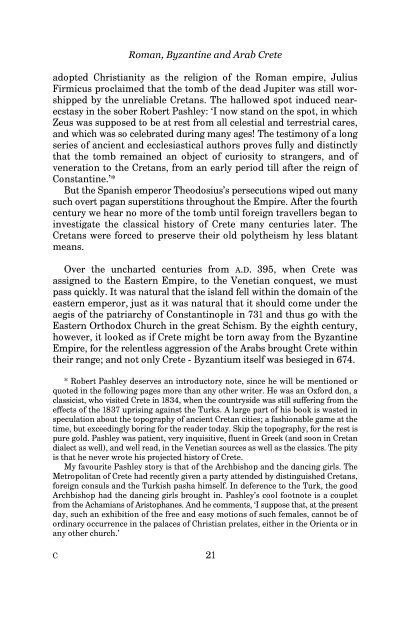free download here - Michael Llewellyn-Smith
free download here - Michael Llewellyn-Smith
free download here - Michael Llewellyn-Smith
Create successful ePaper yourself
Turn your PDF publications into a flip-book with our unique Google optimized e-Paper software.
Roman, Byzantine and Arab Crete<br />
adopted Christianity as the religion of the Roman empire, Julius<br />
Firmicus proclaimed that the tomb of the dead Jupiter was still worshipped<br />
by the unreliable Cretans. The hallowed spot induced nearecstasy<br />
in the sober Robert Pashley: ‘I now stand on the spot, in which<br />
Zeus was supposed to be at rest from all celestial and terrestrial cares,<br />
and which was so celebrated during many ages! The testimony of a long<br />
series of ancient and ecclesiastical authors proves fully and distinctly<br />
that the tomb remained an object of curiosity to strangers, and of<br />
veneration to the Cretans, from an early period till after the reign of<br />
Constantine.’*<br />
But the Spanish emperor Theodosius’s persecutions wiped out many<br />
such overt pagan superstitions throughout the Empire. After the fourth<br />
century we hear no more of the tomb until foreign travellers began to<br />
investigate the classical history of Crete many centuries later. The<br />
Cretans were forced to preserve their old polytheism hy less blatant<br />
means.<br />
Over the uncharted centuries from A.D. 395, when Crete was<br />
assigned to the Eastern Empire, to the Venetian conquest, we must<br />
pass quickly. It was natural that the island fell within the domain of the<br />
eastern emperor, just as it was natural that it should come under the<br />
aegis of the patriarchy of Constantinople in 731 and thus go with the<br />
Eastern Orthodox Church in the great Schism. By the eighth century,<br />
however, it looked as if Crete might be torn away from the Byzantine<br />
Empire, for the relentless aggression of the Arabs brought Crete within<br />
their range; and not only Crete - Byzantium itself was besieged in 674.<br />
* Robert Pashley deserves an introductory note, since he will be mentioned or<br />
quoted in the following pages more than any other writer. He was an Oxford don, a<br />
classicist, who visited Crete in 1834, when the countryside was still suffering from the<br />
effects of the 1837 uprising against the Turks. A large part of his book is wasted in<br />
speculation about the topography of ancient Cretan cities; a fashionable game at the<br />
time, but exceedingly boring for the reader today. Skip the topography, for the rest is<br />
pure gold. Pashley was patient, very inquisitive, fluent in Greek (and soon in Cretan<br />
dialect as well), and well read, in the Venetian sources as well as the classics. The pity<br />
is that he never wrote his projected history of Crete.<br />
My favourite Pashley story is that of the Archbishop and the dancing girls. The<br />
Metropolitan of Crete had recently given a party attended by distinguished Cretans,<br />
foreign consuls and the Turkish pasha himself. In deference to the Turk, the good<br />
Archbishop had the dancing girls brought in. Pashley’s cool footnote is a couplet<br />
from the Achamians of Aristophanes. And he comments, ‘I suppose that, at the present<br />
day, such an exhibition of the <strong>free</strong> and easy motions of such females, cannot be of<br />
ordinary occurrence in the palaces of Christian prelates, either in the Orienta or in<br />
any other church.’<br />
C 21


